|
Driving
Legends
The
Three Musketeers: Fast men in their Mini
Coopers
Paddy
Hopkirk
Patrick
Barron Hopkirk was born in Belfast, Northern
Ireland, on 4 April 1933. After finishing
school, he studied agriculture at Trinity
College in Dublin for three years, then
taking up his studies in engineering.
In 1955 he left university and started
his career as a rally driver first with
Triumph and then with Rootes. During these
early years in motorsport Paddy developed
business interests in Belfast with various
car companies such as the Paddy Hopkirk
School of Motoring and Paddy Hopkirk (Garages)
Ltd.
Although Paddy never adopted Rauno Aaltonen’s
style of applying the brakes with his
left foot (a style of driving, indeed,
destined to make inroads in rally racing),
he nevertheless became one of the fastest
drivers in the sport, finishing third
in the 1962 Monte Carlo Rally at the wheel
of a Sunbeam Rapier. Despite this very
good result, he felt that the Rootes Team
failed to acknowledge his full potential,
so he decided to switch over to the BMC
Team, driving an Austin Healey 3000. When
joining BMC, Paddy entered the scene at
virtually the same time as the Mini Cooper.
And after having thoroughly tested this
small and nimble front-wheel-drive athlete,
he not only felt perfectly at home with
this drive concept, but also set his focus
from now on rally cars built to this principle.
Driving the Mini Cooper, Paddy Hopkirk
gained international recognition through
numerous outstanding victories and top
places in the most challenging events.
Apart from victory in the 1964 Monte Carlo
Rally, his greatest achievements include
the winning title in the 1965 and 1967
Circuit of Ireland, the 1966 and 1967
Alpine Rally, and the 1967 Rally Acropolis.
Finally, over and above this wide range
of racing activities, Paddy Hopkirk also
entered road races such as the Targa Florio
and Sebring.
In 1970, two years after BMC’s Chief
Executive Lord Stokes had closed down
the Works Motorsport Department, Paddy
Hopkirk withdrew from professional rally
racing to concentrate on his business
interests. However, he has not let go
of the sport completely to this very day,
entering the RAC Golden 50, the anniversary
event for the 50th RAC Rally, in 1982
and indeed winning this historical event
together with co-driver Brian Culcheth
in the very same Mini Cooper which had
brought Timo Mäkinen victory in the
1965 Monte Carlo Rally. In 1990, in turn,
Paddy entered the Pirelli Classic Marathon,
bringing home the title together with
co-driver Alec Poole. With Monte Carlo
never losing its outstanding appeal, Paddy
Hopkirk decided to try his luck once again
in 1994, entering the Rally in a new Mini
Cooper together with co-driver Ron Crellin.
Boasting starter number 37 and the L33EJB
number plates front and rear, Paddy battled
it out against far more modern cars and
came home in an impressive 60th place
thirty years after his legendary victory.
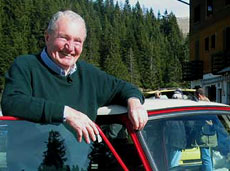
Paddy today |
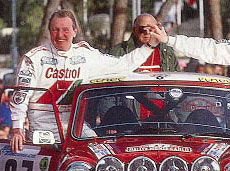
Paddy Hopkirk
at Monte Carlo 1994 |
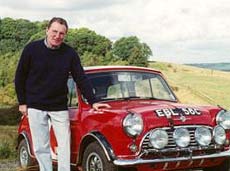
Paddy Hopkirk
and EBL 56C at
Millbrook filming for the BBC |
Rauno
Aaltonen
Rauno
Aaltonen was born in Turku, Finland, on
7 January 1938 – and from the very
beginning he was fascinated by everything
motorsport had to offer: At the tender
young age of 12 he started racing fast
boats on water, winning the Finnish Speed
Boat Championship no less than 7 times
and even bringing home the Scandinavian
Championship at the young age of 20. Another
of Rauno’s passions was motorcycles
where he became a member of the National
Speedway Team and won the Scandinavian
Grand Prix in road racing on a 125-cc
Ducati. At that time he majored at university
in economic science and then dedicated
his attention to rally racing. In summer
he battled for points at the wheel of
a Mercedes, in winter he drove a Saab
and won the Finnish Rally Championship
in 1961.
Rauno Aaltonen joined the BMC Team in
1962, entering the Monte Carlo Rally at
the wheel of a Mini Cooper. Holding second
place just three kilometres from the finish
line, he misjudged a bend and rolled over
the car in a bad accident. With his car
catching fire immediately, Rauno barely
managed to get out and escape the flames
in time. A year later he finished third
overall in the Monte Carlo Rally in his
Mini Cooper and won his particular class,
then finishing 7th in 1964.
After scoring a number of wins and leading
places in international rallies, Rauno
Aaltonen won the European Rally Championship
in 1965.
He then continued his story of success
throughout 1966, moving on to another
highlight in January 1967 when, in his
inimitable style and with the help of
the right tires, he became the overall
winner in the Monte Carlo Rally.
Well-known as the “Flying Finn”,
Rauno spent the following years as a works
driver with Lancia, Saab, and Nissan.
In 1976 he was appointed Chief Instructor
of BMW Driver Training also on account
of his analytical and teaching talents
giving him the nickname “Rally Professor”.
In 1981 the government of Finland honoured
Rauno’s commitment to motorsport
and road safety by making Aaltonen a member
of the Order of the Finnish Lion, and
in Germany he was awarded the Cristophorus
Prize. To this very day, Rauno Aaltonen
remains active in both motorsport and
traffic safety as a very popular driver
and sought-after advisor.

Rauno with
a Ferrari Dino 246 GT |

Rauno
Aaltonen (left) and Lars
Ytterbring on the 1991 RAC Rally |

Rauno today |
Timo
Mäkinen
Timo
Mäkinen was born in Helsinki, Finland,
on 18 March 1938, starting his professional
life by delivering newspapers for his
father’s transport company. But
soon he started racing in ice track events,
subsequently entering circuit races. In
the late ’50s he then hit the headlines
for the first time through his success
at the wheel of a Jaguar D-Type.
Timo entered his first rally in 1960,
sponsored by the BMC importer in Helsinki.
And from now on he knew exactly where
his future was in motorsport: it was in
rally racing. So soon he started to make
a name for himself at the wheel of an
Austin Healey 3000 and the Mini Cooper,
showing particular preference for the
small front-wheel-drive athlete: Mäkinen
was one of the first drivers to prove
the Mini’s potential and develop
the right technique for scoring successful
results in the sporting Cooper. This soon
brought him to the attention of BMC’s
Team Manager Stuart Turner, who hired
Mäkinen for the 1962 RAC Rally, in
which Timo finished 7th overall.
Assisting Mäkinen as the co-driver
in an Austin Healey 3000, Christobel Carlisle
described the Finn’s style of driving
in the following words back in 1963: “After
three hours of driving over one snowbound
pass after the other all I wanted to do
was take the next plane home. Quite honestly,
I was scared out of my mind. He kept on
and on at 130 km/h, power-sliding round
every bend. But nothing ever went wrong.
So I gave in to destiny. And at the end
of the Rally I believed in Timo so strongly
that I was able to push him even harder
in order to meet the time limit.”
This, perhaps, explains Timo’s outstanding
performance in 1965 when he won the snowbound
Monte Carlo Rally far ahead of the competition.
Racing the Austin Healey 3000 and the
Mini Cooper, Mäkinen scored one outstanding
result after the other back in the ’60s.
His victories at the wheel of the Mini
Cooper include the 1964 Tulip Rally, the
1965, 1966 and 1967 Thousand Lake Rallies,
and the 1966 Three Cities Rally. In 1968
he switched over to power boat racing
and immediately won the Finnish Offshore
Championship, subsequently winning the
Round Britain Race in 1969.
Timo Mäkinen continued rally racing
for Ford and Peugeot well into the ’90s.
And like Paddy Hopkirk, he also entered
the 1994 Monte Carlo Rally at the wheel
of a new Mini, even though he was unable
for technical reasons to reach the finish
line.
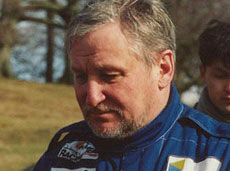
Timo
Mäkinen in 1991 |

Mäkinen
at the wheel of an
Austin-Healey 3000 in the '60's |

Back in a
Cooper |

The 1965 RAC
Rally winners Rauno Aaltonen and
Tony Ambrose share the champagne |

1965 Tulip
Rally Rauno Aaltonen/Henry Liddon |
A
big star in a small car: Rauno Aaltonen
all about Mini and MINI
Do
you remember your first Monte Carlo Rally
in the Mini?
Of course – that was back in 1962.
And it was my first Monte Carlo Rally
ever. Before entering, I had called BMC’s
Motorsport Director Stuart Turner who
I knew from various summer rallies, asking
him about a car for Monte Carlo. He told
me that he had already registered two
cars with Geoff Mabbs and Pat Moss at
the wheel. And since the registration
period had already expired,
I officially became Mabbs’ co-driver.
But in actual fact I was the one who took
the wheel.
What
were your first impressions?
Well, that was the first time a Mini Cooper
was ever raced in a major rally.
And the car was really great! I hadn’t
expected it to be so reliable the very
first time. Just imagine – just
a few specials trials before the finish
line we were second overall!
But
what happened then?
I had an accident. It was dry and I wasn’t
going too fast, but somehow I touched
the cliff on the left-hand side on a narrow
stretch of road, and that was it. The
car flew off the road, rolling over four
times and exploding in flames. Maybe the
right-hand-drive steering was the reason
for my mistake, I really don’t know.
Anyway, my co-driver was able to get out
of the car first, nothing happened to
him.
What
did you like best about the Mini Cooper?
When I saw the car the first time, I was
convinced that it had to be extremely
agile with its wheels right out at the
corners. And I was right! The Team had
really prepared both the car and the engine
excellently, making all the modifications
allowed and possible at the time.
My 1962 Mini Cooper featured a modified
camshaft different from the circuit racing
models, with engine output of approximately
85 bhp. The gear ratios were probably
also different from the standard model.
Obviously, with relatively little power
like this, we had to make up for our disadvantage
elsewhere, driving downhill faster than
the competition. But that was dead easy
with our light and nimble Mini.
But
you still had to be an excellent driver...
Being the “inventor” of the
left-foot-braking technique, I had big
advantages in the Mini Cooper. In fact,
I developed this technique back in 1958
when switching over for the first time
from rear-wheel drive to the front-wheel-drive
Saab. To begin with I kept on ramming
big holes in the snow, since I simply
slid on in a straight line. Being really
nice guys, my colleagues told me there
was a lever in the middle you could also
use for braking! But I felt that using
the handbrake was not logical, since it’s
always better to keep both hands on the
steering wheel. So I developed the left-foot
braking technique on the Saab –
with the additional benefit of exerting
a greater load on the front wheels when
applying the brakes. And for some reason
the other drivers were not that good in
using this technique, not even when I
drove the Mini later.
What
would you have wanted most on the Mini
Cooper back then?
Bigger wheels! We constantly had tyre
problems. Although the shortest special
trial on the Monte Carlo Rally was only
12 kilometers, all the tyre tread was
gone at the end. So 13-inch-tires would
have been much better, and even 12 inches
would have been enough. But somewhat it
never worked out.
Weren’t
the small wheels also a disadvantage in
the snow?
No, because we had by far the best tires
back then. We used Finnish winter tires
and the Finnish tyre industry was years
ahead in developing tires with a good
grip. Since there are no high mountains
in Finland, we don’t use snow-chains.
Instead, manufacturers have developed
high-grip tires making us far superior
to the competition. Later we also had
spikes, but they often overheated on dry
roads and started flying off the tires.
Are
you still in touch with your colleagues
from the old days?
Yes, we meet now and then. Maybe once
a year. Paddy Hopkirk is older than me
and he’s not that active any more.
Timo Mäkinen lives in Helsinki, but
he doesn’t know foreign languages
that well, so he prefers to stay in Finland.
Did
you have any amusing experiences with
the Mini?
Sure. Once, after being disqualified in
1966, I came back in December to practice
for the 1967 Monte Carlo Rally. But it’s
really impossible to drive on Sunday,
since there are simply too many ski tourists
on the roads. So I decided to go skiing
instead. And since there was no parking
space available, I parked the Mini Cooper
right in the middle of the market square.
It was the only car in the entire area.
Within a matter of seconds a French policemen
came running up to me, asking what I was
doing there with my car. He demanded to
see my driver’s licence –
but when he read my name, he said: “Oh,
Mr. Aaltonen, you can do anything you
like!” Then he even apologised for
the organisers of the Rally, saying that
they shouldn’t have disqualified
us! Now, looking back in hindsight, it’s
fair to say that this disqualification
gave the Mini huge popularity and really
made us famous. Maybe more so than even
the best racing win.
Do
you know how many rallies you raced in
the Mini?
No, I really have no idea. But in the
’60s I drove Mini Cooper most of
the time. And that was when I scored more
overall wins than any other rally driver
in the world – nearly all of them
in a Mini Cooper.
When
did you drive the “classic”
Mini the last time?
For the works team in 1968. But in the
mid-80s I raced a private Mini Cooper
in a circuit event.
And
how did it go?
I won. Because the race track was really
very tight with lots of corners.
How
do you like the new MINI?
It’s great! The designers have really
succeeded in capturing the spirit of the
Mini. The car is really unique, much more
outstanding and convincing than all those
so-called retro models. And the driving
feeling is also the same: Both generations
of the Mini or MINI stand out from all
other cars in exactly the same way. They
are extremely agile and follow the steering
immediately. Let me give you a comparision:
Back then the Mini was a Princess, really
beautiful and full of style. Today the
Princess has grown up and the new MINI
has become a Queen.
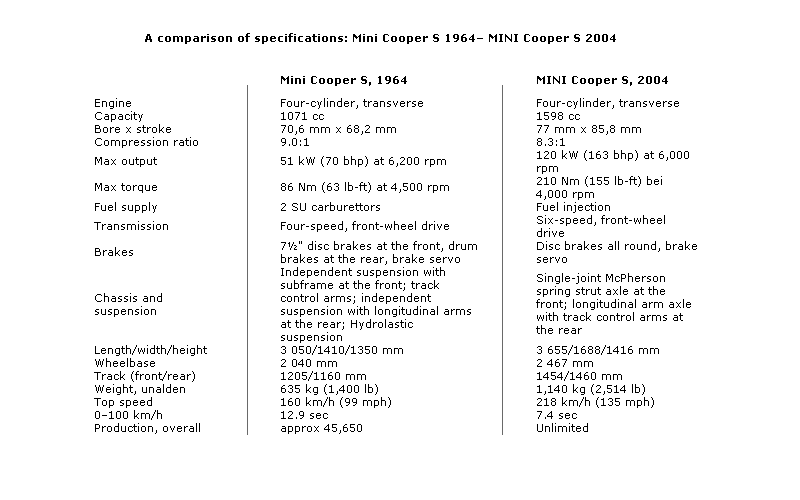
Rauno,
Timo and Paddy were reunited recently
in Monte Carlo and got to drive around
the roads they know so well...
It
was reported on by the Telegraph:
Mini memories
(Filed: 29/01/2005)
Source: www.telegraph.co.uk
Old
Mini or new MINI?
Brian Laban decides, on
the Col de Turini
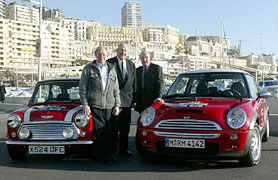 Rauno
Aaltonen, Timo Mäkinen and
Paddy
Rauno
Aaltonen, Timo Mäkinen and
Paddy
Hopkirk reunited recently in Monte
Carlo |
The
road sign says "16 Lacets".
That's 16 hairpins in succession, some
of them almost too steep to walk up or
down, joined by short, narrow sections
of never-quite-straight, never-quite-smooth
asphalt, almost all with sheer rock faces
on one side and vertical drops into oblivion
on the other. Not to mention black ice,
packed snow or the odd rock-fall around
each blind approach.
Four decades have passed since the original
Mini Cooper S first won the Monte Carlo
Rally with a series of giant-killing performances
on these very roads, and most things change
a lot in 40 years. But whether you spell
Mini with lower case letters as in 1964,
or MINI all in capitals, as they do now
it belongs to BMW, the Col de Turini (of
which the 16 consecutive hairpins are
a tiny part) is as thought-provoking as
ever.
Wind
back the clock, to the beginning of 1964,
when the Monte was one of the blue-chip
headline grabbers of the motorsport calendar.
Right up there, in its heyday, with any
grand prix, or Indianapolis, or Le Mans
- and arguably more glamorous than any
of them, thanks to the magical setting
in fairytale Monte Carlo. Back then, in
deep mid-winter, several hundred crews
in the wildest variety of cars - some
professionally prepared, others with not
much more than a few maps and a warm flask
of coffee - set off from points all around
Europe to converge on a common starting
point for the truly competitive bit, in
Reims, followed by a couple of days and
nights of special stages in the icy mountains
above the principality, and a final day
hammering around the Monaco grand prix
circuit to decide who'd won. It was a
Boy's Own Paper adventure, but it was
tough at the top.
In
1964 Paddy Hopkirk and co-driver Henry
Liddon hardly took the easy option by
choosing Minsk, way behind the Iron Curtain,
as a starting point. But the BMC management
clearly thought driving a stripped-out,
rally-prepared Mini from Russia to the
Côte d'Azur in January would be
good publicity - which then as now was
the main object of the exercise.
OK,
so they faced temperatures so low in Minsk
(-26 degrees) that most cars had to be
tow-started; they faced roads that normally
accommodated more tractors and tanks than
rally cars; they faced unreadable road
signs, almost non-existent daylight, minimal
map detail and maximum en-route bureaucracy
at border crossings. And they had to watch
their steps, because someone else always
was, too: Hopkirk's first drama came before
he was even out of Russia when he took
a wrong slot down an unmarked road - but
threw the car into a 180-degree turn when
he realised that the fur hat in the snow
in front of them had a gun.
It
was a gendarme rather than a soldier who
stopped them the second time, deep into
France when they were driving, none too
slowly, down an urban one-way street,
the wrong way. Road penalties in those
days meant rally time penalties, and a
big enough offence - which this probably
was - could mean disqualification. When
the gendarme asked for the crew's official
rally log book to record the digression,
Hopkirk explained that they were going
so quickly in the wrong direction because
he had just been informed that his mother
had died and he was rushing home for the
funeral, no longer in the rally. So that
was OK, and so, of course, was Mrs Hopkirk,
had les vieux Guillaumes bothered to check.
They
arrived at Reims without penalties, to
a jolly reception with excellent champagne
and dodgy food - which caused some other
crews to make additional service halts
the next day, on the run-in through the
mountains to Monte. That 1,400km "common
route'' included five timed "special
stages'', totalling 132km and taking in
23km of the Col de Turini as the final
stage, before the set-piece finale.
The
contest, amazingly, was between the new
front-drive, 1,071cc Cooper S entries
and the big, 4·7-litre, rear-drive
Ford Falcons - works teams head to head
in a classic David and Goliath face-off.
Goliath won the weigh-in and all the opening
rounds, as the fearless Bo Ljungfeldt
set fastest times with his Falcon on every
stage. And it's worth noting just how
scary Ljungfeldt was, even to a team-mate
like F1 world champion Graham Hill, who
was never notably nervy.
Later
he told of following Bo and watching him
pass other cars by throwing the Falcon
up the face of the rocks bordering the
road, then dropping back down. "I
saw him do it time after time,'' said
Hill, "and I still don't believe
it.''
David
pulled out the sucker-punch, though -
or Paddy and Henry did. They'd run the
flying Falcon (and Eric Carlsson's spectacular
Saab) close on every stage, and around
the streets of Monte Carlo, with a little
help from a handicapping system that levelled
the playing field slightly, they did just
enough to win.
Paddy
says it was French journalist Bernard
Cahier who told him they'd done it, and
he wasn't sure whether to believe him
- but it was real enough when Princess
Grace handed over the biggest of the half
dozen trophies they'd won. And Mini won
the team prize, with Timo Mäkinen
and Rauno Aaltonen backing up.
After
it all, Hopkirk, Liddon and 33 EJB, the
winning car, were whisked back to London
to appear on the stage of Sunday Night
at the London Palladium. Mini winning
its first Monte was a big story.
Four
decades on it was BMW, not BMC, which
brought Hopkirk, Aaltonen and Mäkinen,
plus the 1964 winning car, back to Monaco,
and brought the new MINI Cooper S along
to show where four decades of progress
have taken us.
It
has taken the three driving legends to
being a bit greyer maybe, but no less
enthusiastic about sharing a few beers
by the harbourside and talking techniques
(Aaltonen "invented'' left-foot braking,
Hopkirk never got on with it and Mäkinen,
now in his mid-sixties, still takes the
mickey out of both of them).
33
EJB looks tiny, and remarkably standard
- just a few more lights, grippy seats
and a dashboard full of arcane switches
and early 1960s rallying things. The thought
of driving it from Minsk to Monaco isn't
comfortable, but they reckon the car was
fantastic to drive.
Which
takes us back to the Turini. We drove
the classic Mini Cooper up and the new
MINI Cooper S down, and it was magical,
both ways. Nostalgic and still chuckable
going up - ludicrously fast, usually sideways
and tyre-shreddingly, brake smokingly
grin-cracking on the way down.
BMW
has done an honourable trick in celebrating
the Mini heritage without hijacking it,
and there wasn't an original driver there
who didn't think the MINI has captured
at least the spirit of the Mini. Me, too.
Back
to Top
|